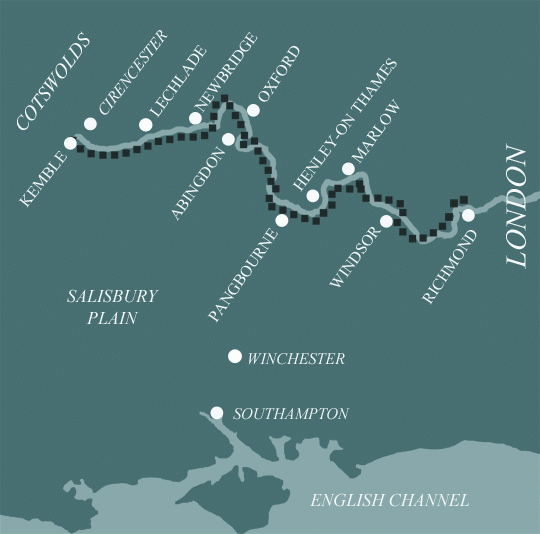Thames Path Central: Oxford to Marlow
Oxford to Marlow in 4 Days Walking Code: TPC5
We offer 2 itineraries on the central section of the Thames Path, following the river from Oxford’s dreaming spires through tranquil meadows and historic locks. Along the way, explore England’s oldest town, medieval castle ruins, and the striking Goring Gap before continuing past Henley, famous for its regatta, to the charming riverside town of Marlow.
Starting with an 18 mile day this itinerary is for experienced walkers. It will be worth the effort when you get to pretty Dorchester-on-Thames. It carries on with a 16 mile day to Pangbourne before easing off on the last two days when you can take it a bit easier and enjoy the river views, arched bridges and historic buildings.
| Miles | Km | ||
|---|---|---|---|
| Day 1 | Travel to Oxford for your first nights accommodation | ||
| Day 2 | Oxford to Dorchester-on-Thames | 18 | 29 |
| Day 3 | Dorchester-on-Thames to Pangbourne | 16 | 26 |
| Day 4 | Pangbourne to Sonning | 10 | 16 |
| Day 5 | Sonning to Marlow | 14 | 23 |
| Day 6 | Depart from Marlow after breakfast |
Oxford to Abingdon
The path skirts the edge of the city, the route is surprisingly green and after passing Iffley lock and the charming Norman Iffley church it continues through its rural setting. Walking through open meadows you pass through Sandford-on-Thames, mentioned in the Doomsday book of 1086 for its milling. Sandford Lock is also known for having the largest fall of 2.69 metres and a weir pool named the Sandford Lasher renowned for its strong undercurrents and taking many lives over the years. An Obelisk marks the spot as a reminder. Continue on past Nuneham House which after Lord Harcourt had it built for him in 1756, also had the original village of Nuneham knocked down and the road from Oxford to London re-routed in order to have the grounds landscaped. Much of this landscaping didn’t survive the second world war. Before reaching Abingdon, you pass an entrance to the Swift Ditch of the back water, originally the faster route on the Thames, and thought to be dug by monks of Abingdon abbey. Abingdon claims to be the oldest continuously occupied settlement in the country with Palaeolithic, Mesolithic, Neolithic and bronze age remains found. Along with evidence of an Iron age and Middle Iron age oppidum (fortified town). Abingdon Abbey was built in the seventh century and gave the town its present name.
Abingdon to Wallingford
This section starts and ends in historical towns. Wallingford is home to the remains of a medieval castle. It was demolished in 1652 on the orders of Oliver Cromwell. It is described by Nicholas Brooks as once being “one of the most powerful royal castles of the 12th & 13th century”. Built on the orders of William the Conqueror. Pass the ancient hamlet of Culham which is virtually surrounded by open fields and after reaching Clifton lock enjoy the picture-perfect scene of the red bricked Clifton Hampden Bridge and the church spire ascending out from behind. Continue on following the sweeping arch of the Thames to Little Wittenham the home for the World Pooh sticks competition and Wittenham clumps also known as the Sinodun Hills which offer magnificent views if you have the energy to climb either of them. A short diversion to Dorchester will allow you to see the impressive ancient Abbey in Dorchester built around 1140 before passing a delightful thatched boathouse at Shillingford and the impressive Benson weir, before reaching Wallingford.
Wallingford to Pangbourne
A contrasting and attractive section starts in the historic town of Wallingford and passes though Goring Gap, a dramatic valley carved through chalk hills by the river during the ice age. Its original route saw the Thames meeting the North Sea near Ipswich but after its paths were blocked by sheet ice it carved its way through the chalk site and took the new route we know today. Today’s section also has one of the few short climbs up the chalk hills and a steep ascent to negotiate at Coombe Park before you reach Pangbourne.
Pangbourne to Henley
Skirting the edge of Reading is quieter than you might think and is broken by Kings Meadow park and the place where the Kennet canal enters the Thames (a project which linked Reading with Bath and Bristol in 1810). On leaving Reading enjoy the 11 different sized archways of Sonning bridge which links the counties Oxon and Berkshire. Pass a beautiful boathouse at Shiplake and probably some boaters out training for an annual Regatta held here, second in size only to Henley. Continue on enjoying the beautiful properties on the Thames edge and the striking Park Place, an imposing country house and some of its prominent features such as the Conway bridge made of massive irregular blocks. This estate at one point being sold for £140 million and makes it Britain’s most expensive house. You enter Henley to rows of moored boats and an array of boating activities taking place. Henley is world-famous for its remarkably straight regatta course, with the first Oxford vs Cambridge race rowed in 1829.
Henley to Marlow
As you leave Henley don’t miss out on taking in the much-photographed bridge and tower of St Mary’s and following the regatta mile route down to its start, marked by a delightfully quaint temple on Temple Island. Follow the river on a shape bend, past a series of weirs at Hambleden Mill and across open fields, and past impressive buildings such as Frogmill Barn and Danesfield castellated mansion to Hurley. Enjoy Hurley lock with its many channels. An area used frequently by kayakers for its four main weir gates and the size and shape of waves created. Carry on to cross the wooden Temple footbridge, put in place to replace the ferry that closed in 1953, and through open meadowland to Marlow. Cross the splendid suspension bridge and enjoy the juxtaposition of the bridge against All Saints pinnacles (a medieval church) which has been well photographed over the years. Marlow is also the home to St Peter’s Church which is said to home the mummified hand of the Apostle St James who was present at the last supper.
Easy to Moderate
Of the National trails we cover, this is one of the easiest. It is a gentle trail which is suitable for people with a wide range of abilities. The route journeys across obvious broad promenades to grassy paths.
Terrain: Mostly flat with well defined paths.
What’s it like underfoot? You may be walking on an obvious trail, path or pavement and occasionally on a path across a field just visible in the grass. The terrain when dry is often compact and easy going, however, when wet it can be muddy in sections.
How much up and down? If you start at the source the route spends the majority of the walk losing height. After you pass through Goring Gap there is a short climb up the chalk hills and steep descent to negotiate at Coombe Park before you reach Pangbourne.
Signposting: Good signposting, signs are marked with a white acorn to indicate the National Trail.
Navigation: Pretty straightforward, keep your map and guidebook to hand.
|
All Holidays
|
|
| Accommodation | Overnight Bed and Breakfast accommodation in selected hotels, farmhouses, village inns, guest houses and family B&Bs. Full English or Continental breakfast. |
| Guidebook | A detailed guidebook with route information, maps, photos and background information. |
| Information of Services Along the Route | A comprehensive Service Info sheet, including services such as cash points, banks, post offices, village shops, inns, cafes and taxis. |
| Maps | A waterproof (1:40,000) Harvey Map covering the whole route. |
| Personal Itinerary | A personal itinerary setting out each overnight stop, including large scale maps of each accommodation, to ensure you find it easily. |
| Emergency Telephone Support | If you get in to difficulties during your holiday, we are always available to help, even out of office hours. |
|
Options
|
|
| Luggage Transport | We will transfer your luggage between each overnight stop – if you leave your luggage at the accommodation when you set off in the morning, it will be moved on to your next B&B. You only need to carry a small day sack with the clothes and provisions you require during the day’s walk. |
| Packed Lunches |
We are unable to pre book packed lunches on this route. However, some accommodations will be happy to prepare a packed lunch if requested on arrival. |
| Off Road Parking | If you are travelling by car we can usually arrange off road parking for the duration of your trip. (There may be a small charge for this). |
| Arrangement of return transport | We can also arrange your transfer back to your car, (or advise you when public transport is a better option)! |
|
What’s not Included
|
|
| Evening Meals | Your evening meal isn’t included in the package, but we include full details and recommendations for each evening meal in your itinerary. You will normally be within walking distance of a pub and/or restaurant, or where there is good food available at the accommodation, we’ll book that for you. Allow about £30.00 per night. |
| Transport to the Start & Away from the Finish | Have a look at the ‘Travel Info’ tab above for suggestions. If you’re still struggling, get in touch and we’ll help you sort it out. |
| Travel Insurance | Even if you are based in the UK travel insurance is worth having. |
Good accommodation and friendly hosts are an essential part of any holiday. We understand this and go out of our way to find the best. We put a great deal of effort into hand picking our accommodation and matching it to individual customer requirements. As well as visiting the accommodation ourselves, we ask all our customers to complete a short evaluation on each night’s accommodation, which then gives us an insight into the day-to-day operation and lets us spot any potential issues before they become a problem.
We use a variety of accommodation. Over the course of your trip you might stay in a village inn, a bed and breakfast in a converted barn, a Victorian guest house, or on a working farm. In selecting the accommodation we look for helpful, friendly hosts with good quality, characterful accommodation close to the trail. Occasionally we may use a chain hotel.
We always try to arrange en suite accommodation, i.e. rooms with their own bathrooms for each night of your stay. However, in some of the more remote locations accommodation is limited and occasionally we may have to book rooms with shared bathrooms for one or two nights of your holiday, (especially if the booking is made at short notice), but we will always let you know if this is likely to be the case.
We are happy to book single rooms on our holidays but cannot normally book more than two for any one group. Single room bookings include a supplement.
Here are some examples of the accommodation we use on the Thames Path:
 The Trout Inn at Tadpole Bridge is a beautifully refurbished boutique inn nestled in the West Oxfordshire countryside. The large beer garden is perfect for sunny days, while the cosy bar and boutique bedrooms offer year-round comfort. Guests can enjoy seasonal dishes, pub classics, and award-winning Butcombe beer. Visit their website
The Trout Inn at Tadpole Bridge is a beautifully refurbished boutique inn nestled in the West Oxfordshire countryside. The large beer garden is perfect for sunny days, while the cosy bar and boutique bedrooms offer year-round comfort. Guests can enjoy seasonal dishes, pub classics, and award-winning Butcombe beer. Visit their website
 The Great House at Sonning is a former Elizabethan coaching inn. This charming riverside escape features stylish rooms, a glass-covered terrace, and a lawned garden leading to the water. Nestled on a peaceful stretch of the river in the picturesque village of Sonning-on-Thames, this is a perfect place to unwind and explore. Visit their website
The Great House at Sonning is a former Elizabethan coaching inn. This charming riverside escape features stylish rooms, a glass-covered terrace, and a lawned garden leading to the water. Nestled on a peaceful stretch of the river in the picturesque village of Sonning-on-Thames, this is a perfect place to unwind and explore. Visit their website
 The Chequers is a charming venue in the heart of Marlow offering cosy, stylish rooms that will have you longing to return time and time again. Known for hearty British cuisine, it serves fresh, seasonal dishes crafted from local ingredients, including signature sharing steaks cooked to perfection, alongside a variety of tempting options. Visit their website
The Chequers is a charming venue in the heart of Marlow offering cosy, stylish rooms that will have you longing to return time and time again. Known for hearty British cuisine, it serves fresh, seasonal dishes crafted from local ingredients, including signature sharing steaks cooked to perfection, alongside a variety of tempting options. Visit their website
 The Hand and Spear in Weybridge is a stylish pub with rooms, offering hearty pub classics and a welcoming atmosphere. Its 12 charming bedrooms are individually decorated, blending comfort and character. Conveniently located near Weybridge station, it’s just 30 minutes from Central London and close to both Heathrow and Gatwick airports. Visit their website
The Hand and Spear in Weybridge is a stylish pub with rooms, offering hearty pub classics and a welcoming atmosphere. Its 12 charming bedrooms are individually decorated, blending comfort and character. Conveniently located near Weybridge station, it’s just 30 minutes from Central London and close to both Heathrow and Gatwick airports. Visit their website
General travel information for the Thames Path walk will be in your holiday pack.
Detailed instructions on getting to your first night’s accommodation by car, or on foot from the nearest train or bus station, will also be included in the holiday pack on individual accommodation maps.
To view train times please visit trainline where you can also purchase tickets in advance. For information on bus timetables please visit traveline
There is no long term parking in Oxford, we can however arrange parking in Marlow at the end of the walk. Please contact us if you are planning to travel by car and we can advise.
Getting to Oxford:
By Air: The nearest airports are Heathrow and Bristol. From Heathrow: either bus to Reading, then train to Oxford or train to Hayes and Harlington, change at Slough for Oxford.
From Bristol airport: Bus to Bristol Temple Meads, train to Oxford, change at Didcot Parkway.
By Public Transport: There is a train station at Oxford. Oxford Railway Station is located on several mainline routes including the Cross-Country Manchester to Bournemouth Line, the Cherwell Valley Line between Didcot and Banbury, and the Cotswold Line between Oxford and Hereford.
By Road: Oxford is located just off Junction 8/8a of the M40 and is clearly signed from all the surrounding A roads.
Returning from Marlow:
By Public Transport: There is a railway station at Marlow. Marlow Station (MLW) is located at the end of the Marlow Branch Line, off the Great Western Main Line at Maidenhead with fast and frequent connections to Bristol Temple Meads and London Paddington.
By Road: Marlow is located just off the A404 on the A4155, a short distance from the M40. Leave the M40 at Junction 4 and follow the A404 southwards towards Maidenhead. Shortly after leaving the M40, you will reach a roundabout with the A4155 then follow signs for Marlow.
Oxford
The ancient university town of Oxford is well worth an extra day. There are many different walking tours of the town which can be booked in advance. You can also visit the Ashmolean Museum and the Museum of Natural History as well as many others. And why not hire a punt and see the river Thames from a whole new perspective!
| Prices | GBP (£) |
|---|---|
| Accommodation, map & guidebook only | £775 |
| with Luggage Transport | £887 |
Other Options |
|
| Extra Nights (per night) | £95 |
| Single Supplement (per night) | £68 |
| Solo Luggage Supplement (per day) | £28 |
